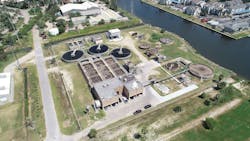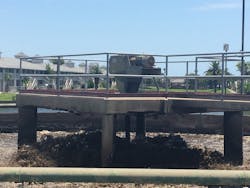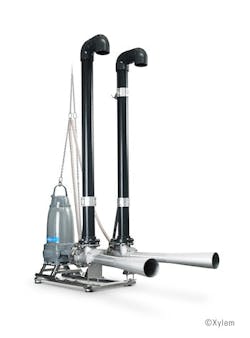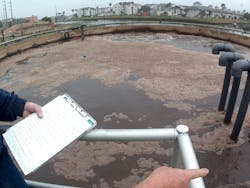Self-Aspirating Mixing System Provides Storm-Resilient Sludge Digestion
About the author:
Jordon Thomas-Harris, P.E., is an engineer at Lockwood, Andrews & Newnam, Inc. (LAN), a national planning, engineering, and program management firm. He can be reached at [email protected].
In early 2017, deterioration and storm damage caused by Hurricane Ike drove the city of Galveston, Texas, to rehabilitate its Airport Wastewater Treatment Plant (WWTP). The city contracted Lockwood, Andrews and Newnam Inc. (LAN), a national planning, engineering and program management firm, to perform the preliminary and final design for this rehabilitation, which would also expand the plant’s capacity from 3.75 million gallons per day (mgd) to 4.76 mgd. In addition to lift station, aeration basin, clarifier and disinfection improvements, a main component of this rehabilitation was to improve the sludge processing at the plant.
Hurricane Ike Destroys Digester Blowers for Aeration
The sludge processing system at the Airport WWTP originally consisted of a 65-foot diameter concrete basin that utilized three blowers located on a concrete pad adjacent to the basin and a coarse-bubble diffuser system to provide aeration and mixing.
This system accomplished partial digestion before the sludge was wet hauled to the city’s Main WWTP to complete the sludge processing. In 2008, the plant sustained significant damage from Hurricane Ike, including the destruction of the existing digester blowers. As an intermediate solution, the city utilized a vertical splash aerator, consisting of a motorized vertical mixing blade suspended from a concrete walkway above the basin, to provide aeration and mixing in the digester. But this method provided inefficient aeration and agitation of hydrogen sulfide gasses, which caused corrosion to much of this structure including the concrete walkway above the digester.
Evaluating Coarse-Bubble Diffusion & Self-Aspirating Aeration Options
Identifying and implementing an energy-efficient, cost-effective replacement for the original coarse-bubble diffuser system and the intermediate splash aeration system was an important aspect of the Airport WWTP rehabilitation. Having a storm-resilient, corrosion-resistant solution was also a top priority for the City due to the continual threat of exposure to hurricanes, major storm events and corrosive salt air.
Standard coarse-bubble diffusion, manifold type jet aeration and self-aspirating type jet aeration systems, consisting of a submersible pump with an aspirated eductor nozzle, were evaluated for use in this application. Manifold type jet aerator systems are commonly used in biological nutrient removal (BNR), sequencing batch reactors and aerobic digester applications, and can function with or without air being fed into the system. This system allows the jet aerators to provide the benefits of both mechanical mixing and diffused air systems. The manifold type jet aeration system provides aeration using stand-alone blowers as an air supply. A standard coarse bubble diffusion system also requires stand-alone blowers for air supply.
But returning to a blower-supplied aeration system would increase the capital costs as well as the operations and maintenance (O&M) costs. Additionally, the existing blower pad was inadequate to meet the current local requirements for placing equipment above flood elevations and would require the concrete pad to be raised to the appropriate elevation. All electrical conduit throughout the plant is routed via elevated cable trays and additional conduit and cable trays would be required to install new blowers.
Other large capital costs required to implement a blower-supplied aeration system included the purchase of the blowers and controls, as well as new corrosion-resistant air piping. Also, the shallow depth of the tank and reduced oxygen transfer efficiency would require blower throughput to be significantly increased to achieve the required aeration, further increasing the operations costs.
The final design solution was also influenced by the previously described concerns that the airport digester is utilized primarily as a sludge holding tank, and final sludge digestion occurs at the Main WWTP facility. Therefore, mixing efficiency was prioritized over aeration capabilities leading to the identification of self-aspirating type jet aeration system as the most advantageous solution for this specific application.
Implementing the Self-Aspirating Aeration System
Once the self-aspirating type jet aerator was identified as the system that most effectively fit the project needs, LAN contacted several manufacturers capable of providing the equipment. To the project team’s surprise, most manufacturers did not have experience installing self-aspirating mixers in a digestion application.
While self-aspirating jet aerators are commonly used in wastewater lift stations and underground stormwater reservoirs for mixing and cleaning, providing simultaneous aeration and mixing to a digester was not a common application for this equipment. LAN worked closely with Xylem, the manufacturer, to identify how best to implement the system at the Airport WWTP digester. Based on the size of the existing basin and the required aeration levels, the capacity and orientation of the aerators was selected and verified by the manufacturer. For this application, three 60 horsepower jet aerators, each having three aspirated eductor nozzles, were placed in a triangular configuration within the tank. The utilization of three jet aerators was recommended by Xylem as a conservative measure for the new application.
Another challenge to implementing the system was the age and stability of the existing tank and adjacent infrastructure. The tank itself was sound and reusable, but the walkway across the structure and access to the walkway needed to be addressed. After evaluating the structural integrity of the walkway, it was decided that the walkway would be demolished while the access to the top of the tank would be improved. Since the self-aspirating type jet aerator system did not require a walkway across the top of the tank, it was a good fit with the design constraints.
Implementing the self-aspirating type jet aerator was a significantly lower capital cost than replacing the digester tank and actually lowered the sludge tank operating costs while maintaining the same overall sludge treatment process at the plant.
Self-Aspirating Aeration System Performance
The improved digester (sludge holding tank) has been in operation for more than six months and the city considers the use of self-aspirating jet aerators to be a success. The sludge mixing in the tank has been more than adequate to maintain the sludge for ultimate digestion at the Main WWTP.
The city has been able to achieve adequate mixing and aeration utilizing a single unit and rotates use of the three units to ensure full tank coverage and extend the useful life of each unit. Because the jet aerators were designed to accommodate maximum loading for the plant, it has been identified that during non-peak scenarios, running all three units can provide aeration and mixing in excess to an extent that a foam layer builds up on the surface of the digester.
To minimize the issues of foaming and to optimize equipment sizing for future projects, additional modeling for aeration and mixing, including computational fluid dynamics modeling, would prove to be beneficial.
Conclusions
The self-aspirating type jet aerator provides a stand-alone system that, due to being rail-mounted and connected to the basin exterior wall, is easily removable with a crane truck and therefore does not require a walkway across the tank. It also has the additional benefit of being a self-contained, submersible system, which made this option the most storm-resilient of the evaluated alternatives.
The $7.24 million rehabilitation of the Airport WWTP was completed in February 2020, with a digester rehabilitation cost of approximately $320,000. By being forward thinking and open to an atypical application for technology, the city of Galveston was able to find an effective and fiscally responsible solution for its sludge processing needs.



